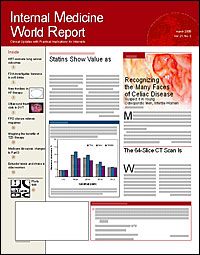Publication
Article
Simple Model Predicts Outcomes in Patients with PE
Author(s):
More than 100,000 patients with acute pulmonary embol?ism (PE) are hospitalized in the United States each year. A new model for easily predicting level of risk in PE patients may help save lives and cut the costs of care (Am J Respir Crit Care Med. 2005;172: 1041-1046).
Investigators randomly assigned 15,531 inpatient discharges with PE to a derivation (67%) or an internal validation (33%) sample. They employed logistic regression, using 30-day mortality as the primary outcome, to determine which demographic and clinical information served as predictors of outcome. They validated the model with the internal validation sample and with a third externally validated sample of 221 inpatients with PE.
Results showed that 11 patient characteristics?all of which can be easily obtained at the bedside?were independently associated with mortality; assigned scores were used to stratify patients into 1 of 5 risk categories (Table).
Risks of mortality and other adverse outcomes in each of the 5 risk classes were similar in all 3 samples. For example, the incidence of 30-day mortality among patients classified as very low risk, or class I, were 1.1% in the derivation sample, 1.6% in the internal validation sample, and 0% in the external validation sample. For class V patients, the corresponding incidences were 24.5%, 23.9%, and 10%.
Information on the incidence of nonfatal cardiogenic shock or cardiorespiratory arrest was not available for the external validation sample. But in the derivation and internal validation samples, incidences again agreed by class: 0.6% versus 1%, respectively, for class I patients, and 4.6% versus 5.3% for class V patients.
"Our rule provides clinicians with an explicit tool for identifying very-low-risk and low-risk patients with PE who may be potential candidates for outpatient treatment or early hospital discharge," writes Drahomir Aujesky, MD, MSc, of the University of Lausanne, Switzerland, and colleagues. They added that even if it is applied to "only a small proportion of patients with PE [it] is likely to result in substantial cost savings."
Although the rule also accurately identifies patients who are at higher risk of early mortality or other adverse outcomes, the investigators concede that it is unknown whether such patients would benefit from closer surveillance or more intensive care.
"It is important to note that our rule is intended to supplement, not replace, clinical judgment," they cautioned.






